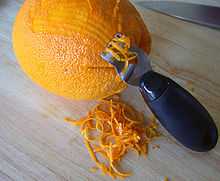Zest (ingredient)

Zest is a food ingredient that is prepared by scraping or cutting from the outer, colorful skin of unwaxed citrus fruits such as lemon, orange, citron, and lime. Zest is used to add flavor ("zest") to foods.
In terms of fruit anatomy, zest is obtained from the flavedo (exocarp) which is also referred to as zest.[1] The flavedo and white pith (albedo) of a citrus fruit together makes up its peel. The amounts of both flavedo and pith are variable among citrus fruits, and may be adjusted by the manner in which they are prepared. Citrus peel may be used fresh, dried, candied, or pickled in salt.
Preparation
For culinary use, a zester, grater, vegetable peeler, paring knife, or even a surform tool is used to scrape or cut zest from the fruit. Alternatively, the peel is sliced, then excess pith cut away.
The white portion of the peel under the zest (pith, albedo or mesocarp) may be unpleasantly bitter and is generally avoided by limiting the peeling depth, though not all fruits will exhibit this. The pith can be used for cooking.
Uses
Zest is often used to add flavor to different pastries and sweets, such as pies (e.g., lemon meringue pie), cakes, cookies, biscuits, puddings, confectionery, candy and chocolate. Zest also is added to certain dishes (including ossobuco alla milanese), marmalades, sauces, sorbets and salads.
Zest is a key ingredient in a variety of sweet and sour condiments, including lemon pickle, lime chutney, and marmalade. Lemon liqueurs and liquors such as Licor de oro require zest.
Zest is used in some cocktails not only for flavor and aroma but also for color as a garnish. For use as a cocktail garnish, zest often is cut in a long spiral called a twist. Cocktails featuring a twist include Dry Martini and Horse's Neck. For maximum flavor and aroma, as in mulled wine, zest is simply cut from the fruit with a knife.
Commercial uses
The flavedo is the source of citrus essential oils (orange oil, lemon oil, etc.), which are important flavorings. Lemon essential oil is the principal flavor ingredient in lemon drops. Restaurants typically use a large quantity of zest.
References
| Look up zest in Wiktionary, the free dictionary. |
| Wikimedia Commons has media related to Citrus zest. |
| ||||||||||||||||||||||||||||||||||||||||||
